The Statue of Liberty is the apex of national mythmaking, a bloated bronze symbol standing watch over New York Harbor, where it broadcasts a promise of generosity, hospitality, and openness to immigrants in need. Emma Lazarus exemplified this ethos in her 1883 sonnet “The New Colossus,” dubbing Lady Liberty the “Mother of Exiles.” But for many—especially immigrants of color—the experience of arriving and settling in the United States falls short of these lofty ideals, and artists have used this symbol to interrogate this projection of America as a haven for the world’s less fortunate, revealing its racialized biases.
Pacita Abad’s painting L.A. Liberty, 1992, came about after a visit to New York’s Ellis Island, where she saw that the narrative of immigration being mythologized largely celebrates the experience of white Europeans arriving in the first half of the twentieth century, excluding later immigrants of color like herself. Countering this erasure, the artist recasts Lady Liberty as—to use a particularly apt phrase coined by Faith Ringgold in a 2003 essay to describe Abad—an “international woman of color,” a simply worded description that wonderfully encapsulates many of the qualities that make Abad unique: her global perspective, which was rare before the biennialization of the art world in the late 1990s; her feminist commitment to elevating craft, specifically textile arts, to the status of art; her aesthetic sensibilities, which revel in color, pattern, and ornament, challenging the Western masculinist dismissal of such traits as decorative and degenerate; and her political solidarities with the peoples of the so-called third world, forged in a post–Bandung Conference era of postcolonial liberation and optimism. More than one hundred examples of Abad’s work are currently on view at the Walker Art Center, Minneapolis, in a retrospective organized by Victoria Sung.
Abad’s compositions are not simply appropriations or erasures of cultural differences but tributes to commonalities and solidarities; they are icons of global Indigeneity.
Abad’s Liberty, who was based on a close friend, is darker skinned but racially multivalent; she could be Filipinx, like Abad, or Latinx (some have suggested that the “L.A.” might stand for “Latin America”), symbolizing the thousands of Asian and Latin American immigrants who have entered the United States through its western and southern borders. A dizzying patchwork of colorful patterns replaces her neoclassical robes, and painted dots and plastic buttons adorn the tablet she holds in her left hand. Echoing the spikes on her crown, a Technicolor starburst radiates out from behind her. Abad’s Liberty displays the syncretism of vernacular images of Christ and the Virgin Mary produced across the Spanish colonial worlds, including the artist’s native Philippines. Liberty is an Indigenous goddess, an icon who represents the multicultural makeup of contemporary America more accurately than Frédéric Auguste Bartholdi’s monument; she is a joyous fever dream of racial and cultural difference expressed through and as color, pattern, and ornament. As Abad proudly proclaimed in 1991 when questioned about her artistic contribution to America: “Color! I have given it color!”

Abad was born in 1946 in Batanes, the northernmost province in the Philippine archipelago. Hailing from a large political family, she grew up in Manila and eventually found herself immersed in student activism while at the University of the Philippines. In 1970, after Abad’s house in Batanes was machine-gunned by her father’s political opponents, she left for Madrid to study law. A stopover in San Francisco to visit an aunt exposed her to the city’s vibrant counterculture, and Abad’s encounter with artists, musicians, and other freethinkers there prompted a shift in her life trajectory. She met her partner, Jack Garrity, and in 1973, the two of them embarked on an epic yearlong road trip from Turkey to Laos on the so-called hippie highway, eventually traveling to Hong Kong, Taiwan, and the Philippines. Abad’s lifelong obsession with the textile arts began on this journey, as she picked up samples from the places they visited. Over the subsequent three decades, Garrity’s job as a development economist took him to countries in Asia, Africa, Latin America, and the Caribbean; Abad always accompanied him, and together they led an itinerant life, traveling throughout the Global South. Abad came to view textile as a universal art form, seeking out examples wherever she went. Throughout her life, she would work closely and collaboratively with communities of textile makers she encountered, learning mirrorwork from artisans in Rajasthan and teaching oil painting in return for batik techniques while living in Jakarta between 1993 and 2000.
Abad is best known for her trapuntos, large-scale paintings on unstretched canvas that she stitched and stuffed to create soft fabric reliefs. She further embellished these tufted surfaces with bits of lace, ribbons, buttons, patterned cloth, sequins, beads, cowrie shells, and the occasional found object. Between their brilliant palettes and their surfeit of ornamentation, Abad’s trapuntos dazzle the eye and deliver a haptic charge. Her art is capacious; it is difficult to tease apart the distinct cultural references and techniques she combines in a particular work. She did not simply appropriate the Indigenous motifs and textile traditions, processes, and materials of the many places she visited and lived in so much as internalize and then synthesize them into a vision that is uniquely hers. The stitch in Abad’s trapuntos, always done by hand, serves multiple functions: It follows painted outlines and contours, often blending into them; it sutures pieces of cloth to one another or to the surface of a canvas in a manner similar to quilting or appliqué; it holds ribbons, buttons, sequins, mirrors, shells, and embellishments in place; it adds texture within painted sections, like a hatch mark or a brushstroke. This variability comes into view on the trapuntos’ versos, which feature dense fields of meandering and intersecting broken lines of multicolored stitches.
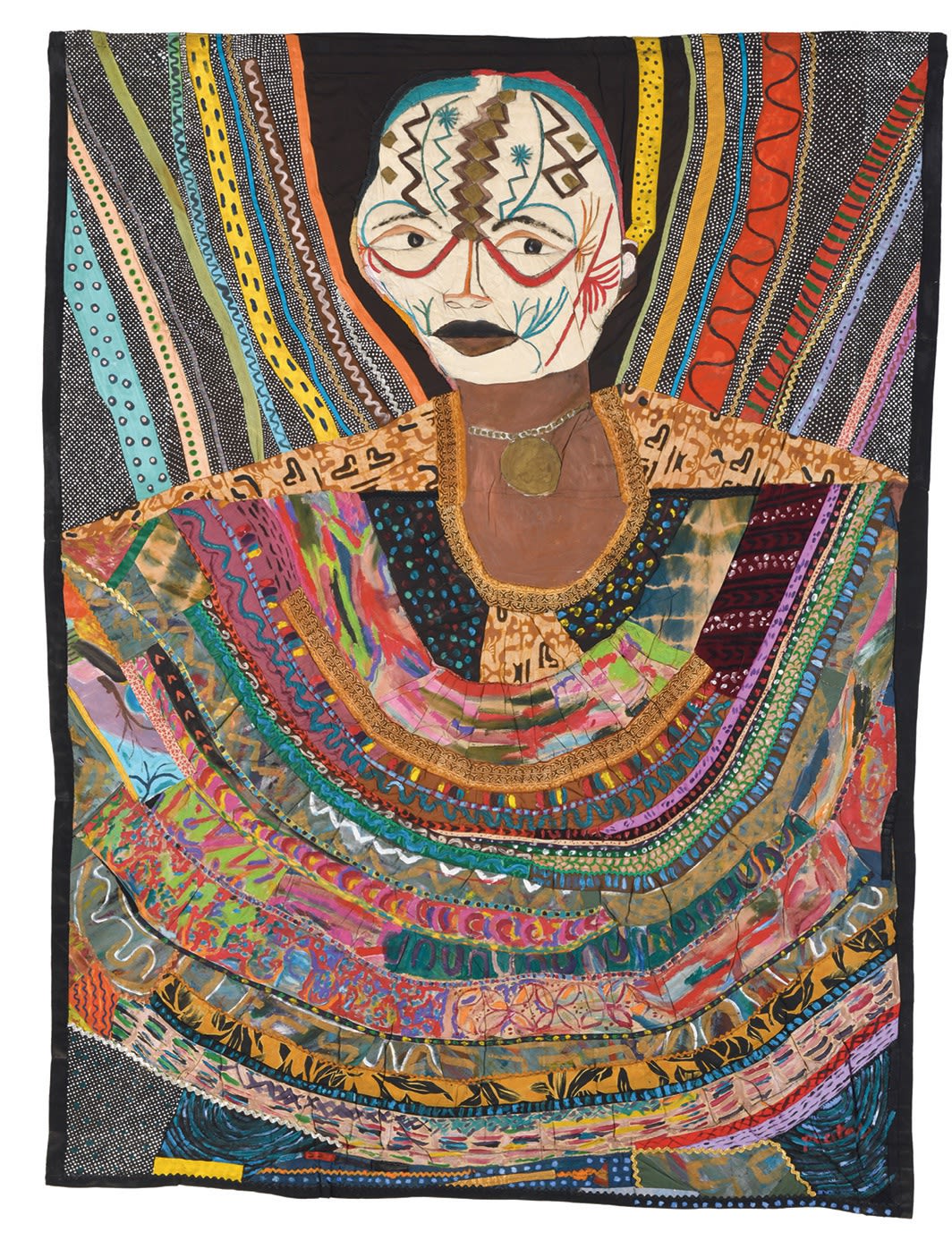
Pacita Abad, African Mephisto, 1981, acrylic, rickrack ribbons, tie-dyed cloth, and painted cloth on stitched and padded canvas, 106 × 71". From the series “Masks and Spirits,” 1981–2001. © Pacita Abad Art Estate.
Like Ringgold, Abad drew inspiration from portable Tibetan Buddhist thangkas. These objects, which can be rolled up like scrolls, suggested to Abad that unstretched canvas would be a practical medium given her peripatetic lifestyle. African Mephisto, 1981, her first known trapunto, also inaugurated the series “Masks and Spirits,” 1981–2001, a group of works focusing on Indigenous masking traditions. Created following two stays in Sudan in 1979 and 1980, African Mephisto features a ghostly white head—decorated with elaborate tribal markings and thick lips, stuffed so that they protrude—that was based on a portrait of a Dinka man Abad painted while there. She combined this bust with a patchwork of undulating semicircular bands of patterned cloth—some acquired on that trip, others painted by Abad herself—inspired by woven baskets she saw in Omdurman, which constitute a cape the figure wears. Abad incorporated more collaged elements into this transitional work than would be present in her subsequent pieces, and, as an archival photograph shows, she initially left its lower left edge uneven, only later adopting the rectangular frame that would become standard for her trapuntos. The work’s title refers in part to István Szabó’s award-winning 1981 film, Mephisto, about an actor in Nazi Germany who sells his soul to the regime in return for success and acclaim. By modifying Szabó’s title with the word African, Abad hints at the debt owed by the European theatrical avant-garde to much older African performance traditions. The more-than-sixteen-foot-tall Marcos and His Cronies, 1985–95, another key work in the “Masks and Spirits” series, is one of Abad’s rare explicitly political works. It adapts the wooden masks used in a Sinhalese exorcism ritual to parody the Philippine dictator Ferdinand Marcos. In a field encrusted with colorful buttons signifying the many thousands he oppressed, Marcos appears as a disease-ridden demon flanked by eighteen of his political associates, each represented by a smaller mask adorned with gleaming fangs. He stands atop the head of his wife, Imelda, who was notorious for her love of ostentatious jewelry and shoes, and whose toothy grin Abad whimsically studs with rhinestones.
Abad enmeshes her figures in a profusion of brushstrokes, colors, patterns, and embellishments.
The artist’s most recognizable works from the “Masks and Spirits” series are a group titled Bacongo. All of them begin with the same near-symmetrical silk-screen print, a set of which Abad had produced at a rug manufacturer in Manila while living there between 1982 and 1986. Titling the suite after a neighborhood in Brazzaville, the capital of the Republic of the Congo, Abad adapted the incised grooves characteristic of Central African Kongo masks, translating them into a flattened and abstracted pattern, the visage’s narrowed eyes set within segmented sockets. Vertical and zigzagging bands, spirals and concentric circles, starbursts, nested squares, and other decorative motifs fill the rest of the frame. Abad then individualizes each silk screen through distinct colorways and ornamental choices. For example, the fuchsia-heavy Bacongo III, 1986, features Indian mirrorwork, while the earthier palette and use of cowrie shells in Bacongo VII, 1987, evoke Indigenous Australian painting. The shared serialized base of this body of work makes it feel almost universal, positing the mask as a foundational motif shared by many cultures. Like Abad’s practice in general, these compositions are not simply appropriations or erasures of cultural differences but tributes to commonalities and solidarities; they are icons of global Indigeneity. To me, the Bacongos, with their wily trickster eyes, also read as reparative spirits, as a celebration of Indigenous knowledge systems, cosmologies, and ritual practices in the face of the devastation wreaked by colonialism and capitalism, which appears to have foreclosed the fate of our species and all the others with whom we share this Earth.
Abad adapted one of her Bacongos for Masks from Six Continents, 1990, a major public art commission for Washington, DC’s central transit hub. Inspired by the diversity of the people she encountered on the city’s metro, her mural consists of six trapuntos, one for each continent (with Oceania added to the standard territorial five). Five feature masks belonging to specific Indigenous traditions, with the trapunto representing Europe being the only exception; for this, Abad repurposed one of her Bacongos, adding bands decked out in a colorful modernist grid to each side. Titling this work European Mask, 1990, she cheekily rerouted colonialism’s reductive logic, which homogenizes the cultural diversity of entire continents under a single geographic label, applying it instead to Europe.
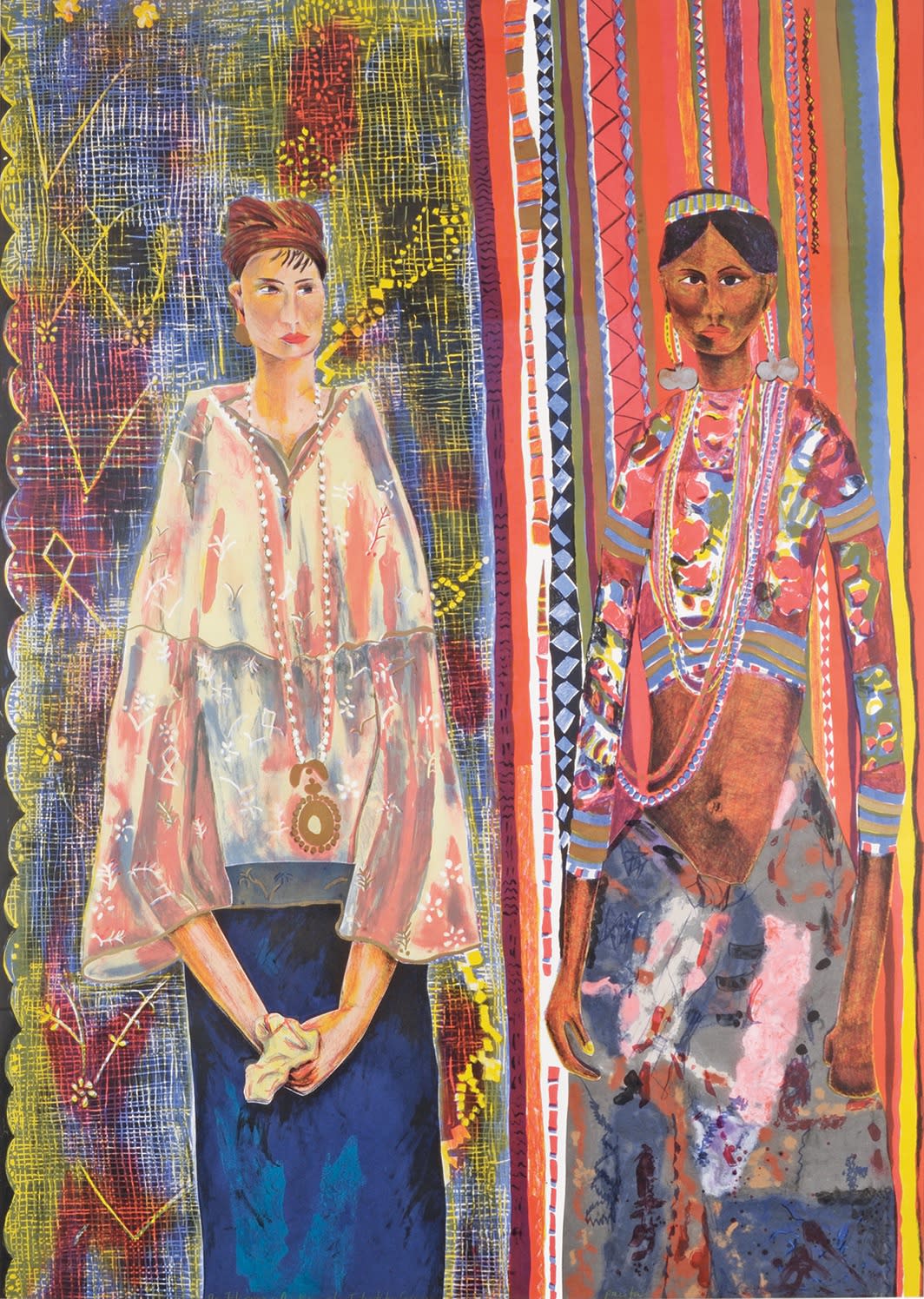
Pacita Abad, Filipina: A Racial Identity Crisis, 1992, lithograph with pulp-painted chine collé and metallic powder on paper, 421⁄2 × 301⁄4". © Pacita Abad Art Estate.
L.A. Liberty is part of Abad’s “Immigrant Experience” series, 1990–95, which she completed while living in Washington, DC. No doubt inspired by her own experience of migrating from the Philippines to the United States at a young age, the body of work also captures the cosmopolitan community she was part of while there. What distinguishes “Immigrant Experience” is the diversity of its subjects. Rather than deploying markers of identity that strictly align with her cultural origins, Abad, without compromising the series’ intimacy, instead evinces a solidarity across lines of race, ethnicity, nationality, and language. Filipina: A Racial Identity Crisis, 1990, distills the complexities of race in the Philippines—which, like other archipelagoes with long histories of colonialism, is culturally and racially syncretized—into a stark binary. Abad juxtaposes a fair-skinned figure, dressed in a Spanish-influenced outfit associated with Filipino elites, with a darker woman in colorfully patterned Indigenous clothing. In the context of the “Immigrant Experience,” the image also demarcates the racialized poles of identity in the United States. Some immigrants seeking a better life aspire to whiteness and the privileges associated with it. Of native Ivatan descent, with a kayumanggi (tropical brown) body herself, Abad was unequivocal about which end of this spectrum she identified with.
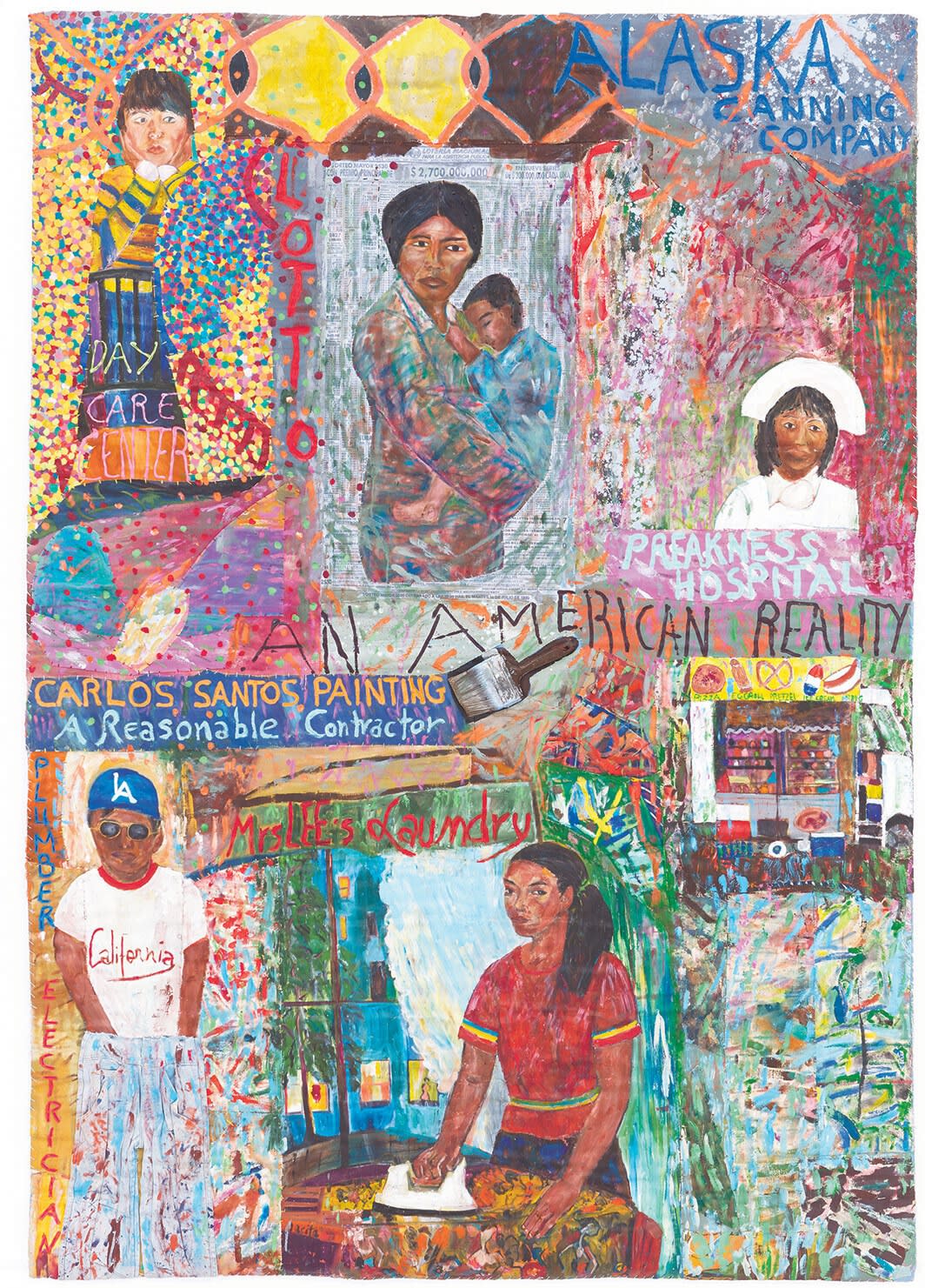
Pacita Abad, I Thought the Streets Were Paved with Gold, 1991, acrylic, oil, paintbrush, painted canvas, and painted cloth on stitched and padded canvas, 94 × 68". From the series “Immigrant Experience,” 1990–95. © Pacita Abad Art Estate.
Abad’s subjects were as multifarious as the many textile traditions she drew on.
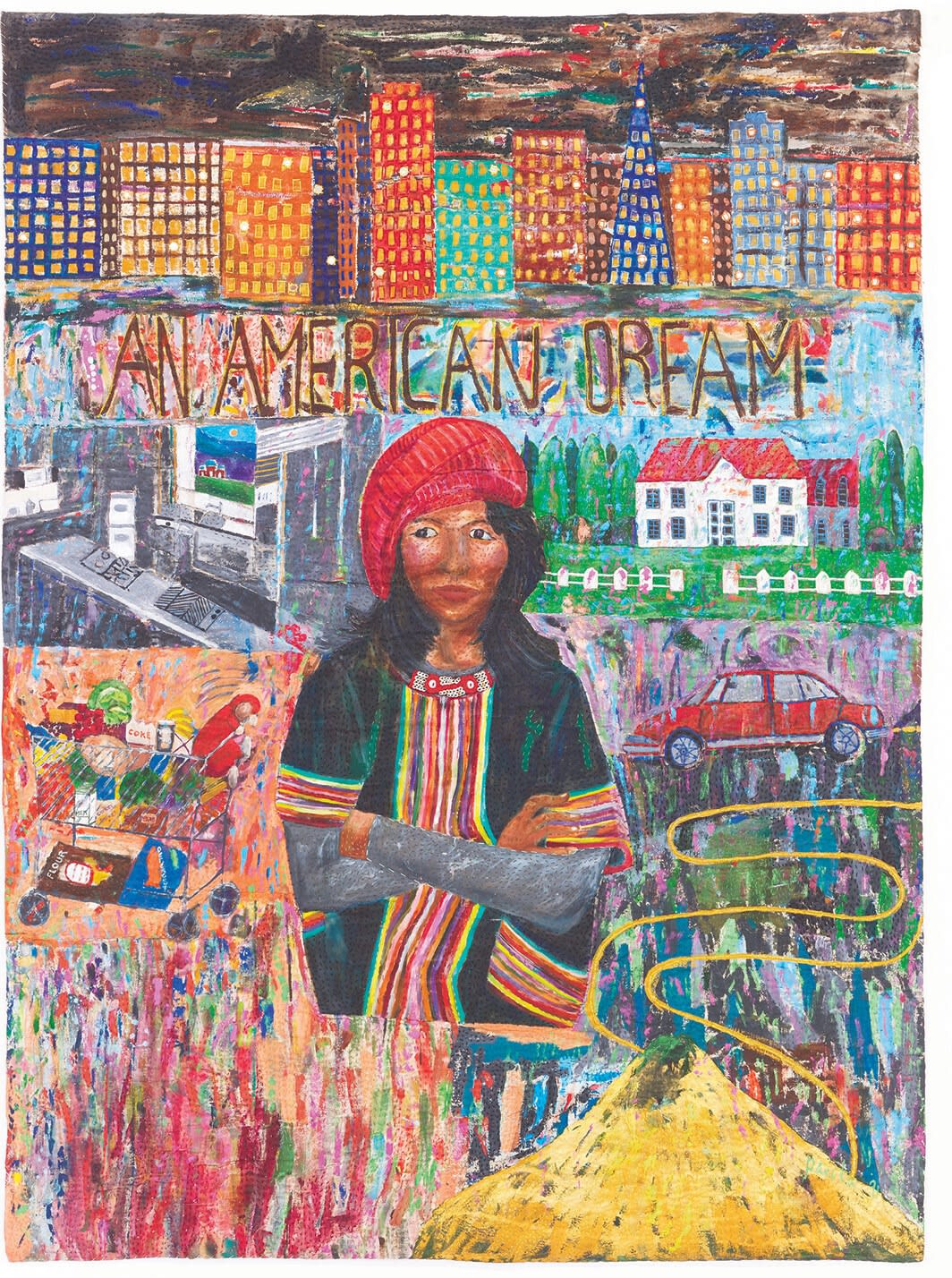
Pacita Abad, If My Friends Could See Me Now, 1991, acrylic, painted canvas, and gold yarn on stitched and padded canvas, 94 × 68". From the series “Immigrant Experience,” 1990–95. © Pacita Abad Art Estate.
Many of the central figures in “Immigrant Experience” are based on friends and neighbors. Abad enmeshes them in a profusion of brushstrokes, colors, patterns, and embellishments. She also includes text, often signage and brand names, inflecting these socialist-realist portraits with a crude Pop sensibility, as if consumer marketing represented the American vernacular. A related pair of works interrogate the promise of a better life that draws many immigrants to the United States. In If My Friends Could See Me Now, 1991, the material trappings of success—a house with a white picket fence, a kitchen outfitted with the latest appliances, a baby in a shopping cart overflowing with groceries, and a car—surround a young woman of color who may or may not be the artist herself. The phrase AN AMERICAN DREAM floats above her. Despite the title’s suggestion of accomplishment, the image feels sardonic: The woman looks stern, with her arms crossed, and a snaking path ends in a proverbial pile of gold, indicating that the promise of success is a mirage. I Thought the Streets Were Paved with Gold, 1991, makes the immigrant’s disillusionment explicit, presenting, as spelled out across the center of the canvas, AN AMERICAN REALITY. Images of a nurse, a day-care worker, a laundress, a housepainter, and a food truck—and texts in all caps that say ALASKA CANNING COMPANY, PLUMBER, and ELECTRICIAN—catalogue the precarious care and service work and menial labor that new immigrants are forced to perform to survive. These images orbit those of a mother and child—the larger figure possibly a representation of a nanny, though the child’s dark skin complicates that reading. Visible through the harried brushstrokes of the light-gray rectangle that frames them are lottery results, with LOTTO spelled out vertically in prominent red letters along the composition’s left edge. The harsh reality for many immigrants is that achieving the mythical American dream often requires dumb luck as much as hard work.
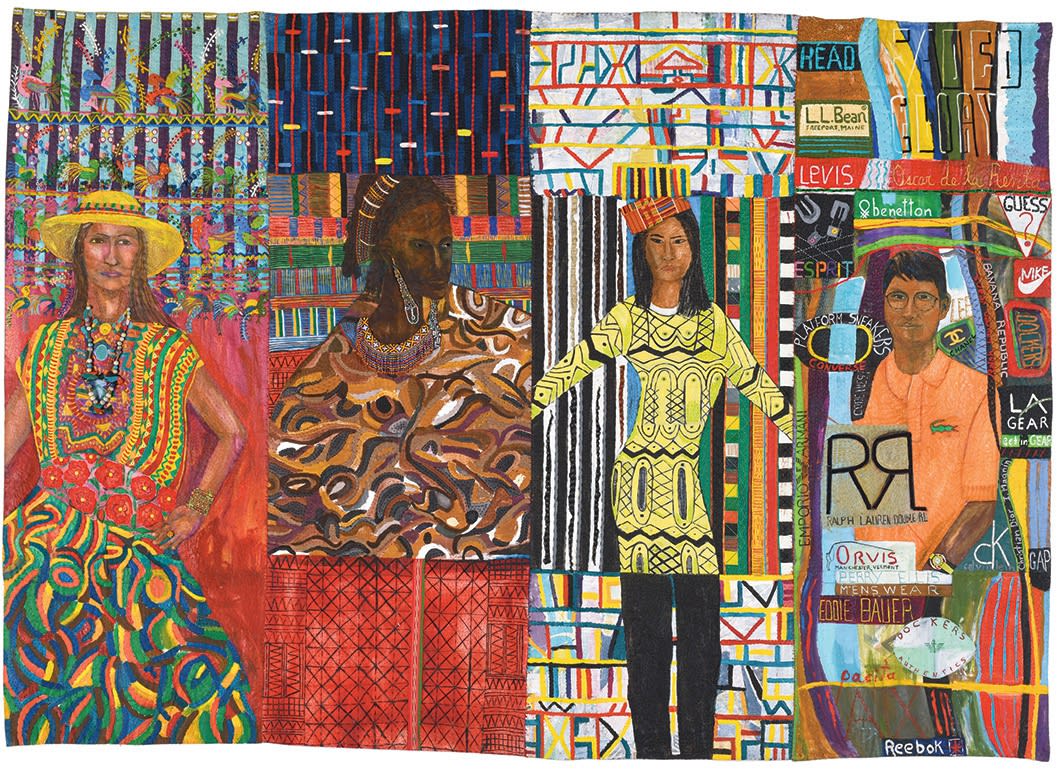
Pacita Abad, Cross-Cultural Dressing (Julia, Amina, Maya, and Sammy), 1993, oil, cloth, and plastic buttons on stitched and padded canvas, 8' × 11' 4". From the series “Immigrant Experience,” 1990–95. © Pacita Abad Art Estate.
Other works in the series show how complex and fraught migration and assimilation can be. The Village Where I Came From, 1991, is a pastoral paean to homes and loved ones left behind, while Cross-Cultural Dressing (Julia, Amina, Maya, and Sammy), 1993, and From Doro Wat to Sushi and Chicken Wings and Tings, 1991, celebrate sartorial and culinary diversity respectively, highlighting the important role food and dress play in maintaining ties to those places. In New Kids in Class, 1994, a young boy holding an American flag stands in front of a blue wall covered with alphabets and words in both English and Spanish, a reminder that the rights and privileges of citizenship are conditional, requiring English proficiency. Pennants and crests of various elite American universities surround a young woman of color in How Mali Lost Her Accent, 1991. A frieze of campus buildings along the top echoes a row of desktop computers at the bottom. One monitor reads MANAGING YOUR MONEY, hinting at the tremendous financial burden higher education entails, while the work’s title suggests that upward mobility requires the shedding of markers of cultural difference.
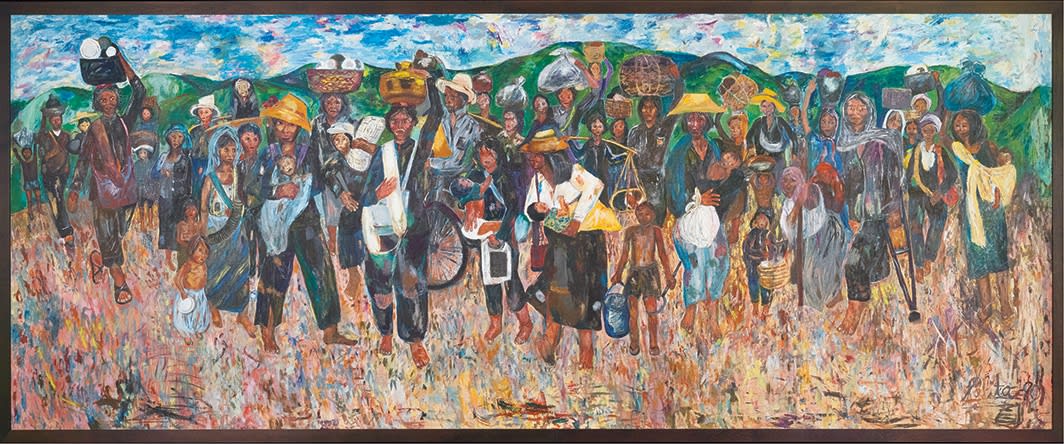
Pacita Abad, Flight to Freedom, 1980, acrylic and oil on canvas, 6' 5“ × 8' 101⁄4”. From the series “Cambodian Refugee,” 1979–80. © Pacita Abad Art Estate.
Abad’s “Immigrant Experience” series complements these scenes of acculturation to life in the United States with vignettes depicting the struggles faced by migrants and refugees around the world. These trapuntos build on her “Cambodian Refugee” series, 1979–80, a body of social-realist and ethnographic works on canvas she created while based in Bangkok. Abad made several trips to the camps along the Thai-Cambodian border housing those fleeing the Khmer Rouge, spending time there speaking to, sketching, and photographing the inhabitants; the resulting images portray the resilience and strength of these refugees even as they are stuck in a seemingly interminable limbo. Haitians Waiting at Guantanamo Bay, 1994, repeats a motif from that series, showing a group of refugees behind barbed wire. Caught at the Border, 1991, depicts a brown-skinned man forlornly grasping at the fence that holds him in, his confinement emphasized visually by a broad bluish-gray frame filled with squiggles and blobs. Though over three decades old, and possibly inspired by Abad’s own run-ins with immigration authorities, the work feels current, recalling the Trump administration’s monstrous family-separation policy at America’s southern border. Two other works hold personal significance, focusing on the plight of migrant Filipina domestic workers. Cynically lionized by the Philippine government for their vital contributions to the country’s economy, these women endure harsh working conditions abroad. Filipinas in Hong Kong, 1995, portrays a weekly Sunday ritual that continues into the present, when, on their sole day off, countless domestic workers occupy the city’s many empty downtown plazas. In a grid of vignettes beneath a Hong Kong skyline festooned with luxury-brand logos, Abad shows the women gathering in encampments made out of cardboard boxes and discarded carrier bags, their humble attempt to forge community away from home. Torments of a Filipino Overseas Worker, 1995, portrays an uncharacteristically dark close-up of a shattered face; flattened and abstracted like the Bacongos, it suggests a subjectivity and identity in crisis.
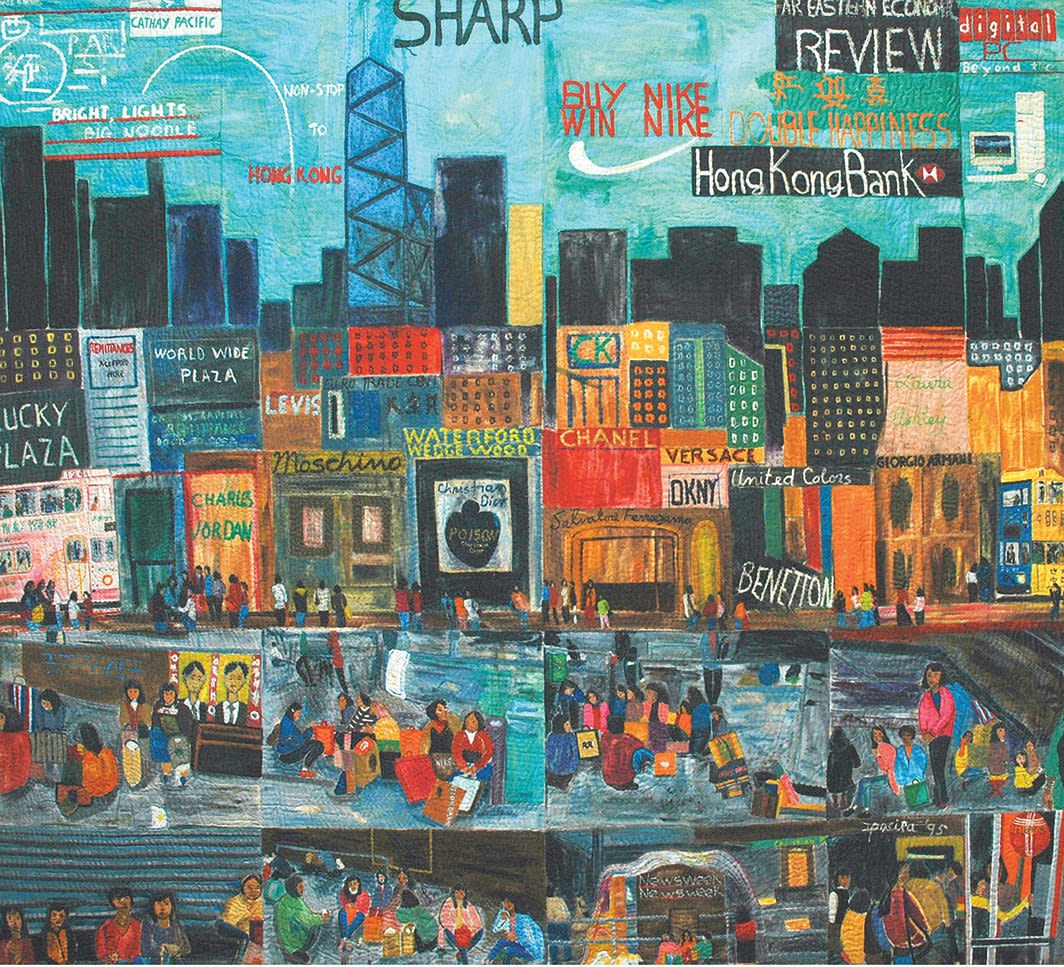
Pacita Abad, Filipinas in Hong Kong, 1995, acrylic on stitched and padded canvas, 106 × 118". From the series “Immigrant Experience,” 1983–95. © Pacita Abad Art Estate.
Abad's subjects were as multifarious as the many textile traditions she drew on, ranging from the traditional Indigenous motifs and artifacts and the social realism of the works discussed above to the rhythmic sweeps and arcs of her “Asian Abstractions” series, 1983–92, inspired by Korean ink-brush painting; the more spontaneous allover gestural abstractions of her “Abstract Emotions” series, 1984–2004; and the dense, nervy, jazz-and-blues-inspired “Endless Blues,” 2001–2003, which sought to process and expunge collective and personal trauma, from the 9/11 attacks and the ensuing War on Terror to Abad’s diagnosis of and eventual death from cancer in 2004. In retrospect, what is perhaps most astounding about Abad’s practice is that she often worked on these disparate series concurrently, producing an oeuvre whose diversity belies an unapologetically undisciplined artistic vision that was intersectional and relational in truly unexpected ways and far ahead of its time.
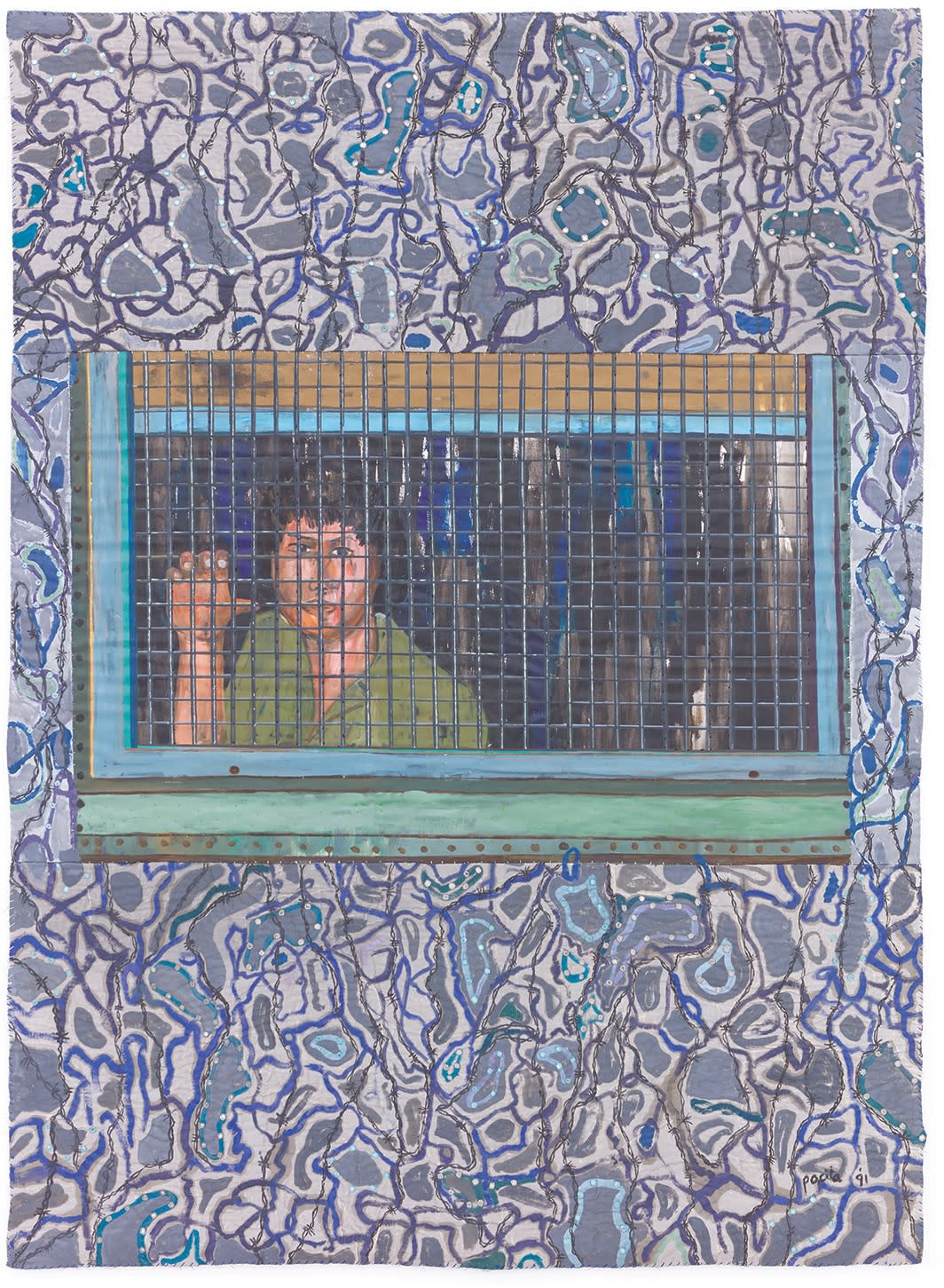
Pacita Abad, Caught at the Border, 1991, acrylic, oil, mirrors, and sequins on stitched and padded canvas, 98 × 68“. From the series “Immigrant Experience,” 1983–95. © Pacita Abad Art Estate.
In addition to all these other passions and pursuits, Abad was an avid scuba diver. Between 1983 and 1996, she produced her most idiosyncratic body of work, a series of trippy kaleidoscopic undersea scenes inspired by dives she made around the Philippines. Bright-hued fish and other marine life weave through a vibrant profusion of coral fans, dissolving through their prismatic excesses long-held distinctions between the optic and the haptic. These works seem to illustrate and activate the amalgamation and superimposition of otherwise discrete senses that feminist scholar Eva Hayward calls “fingeryeyes”—a mode of tactile co-sensing, both in terms of perception and comprehension, that extends across the human and the more-than-human. These works embed the undeniable pleasures of color, pattern, and ornament back into the natural realm, where they arguably originate.
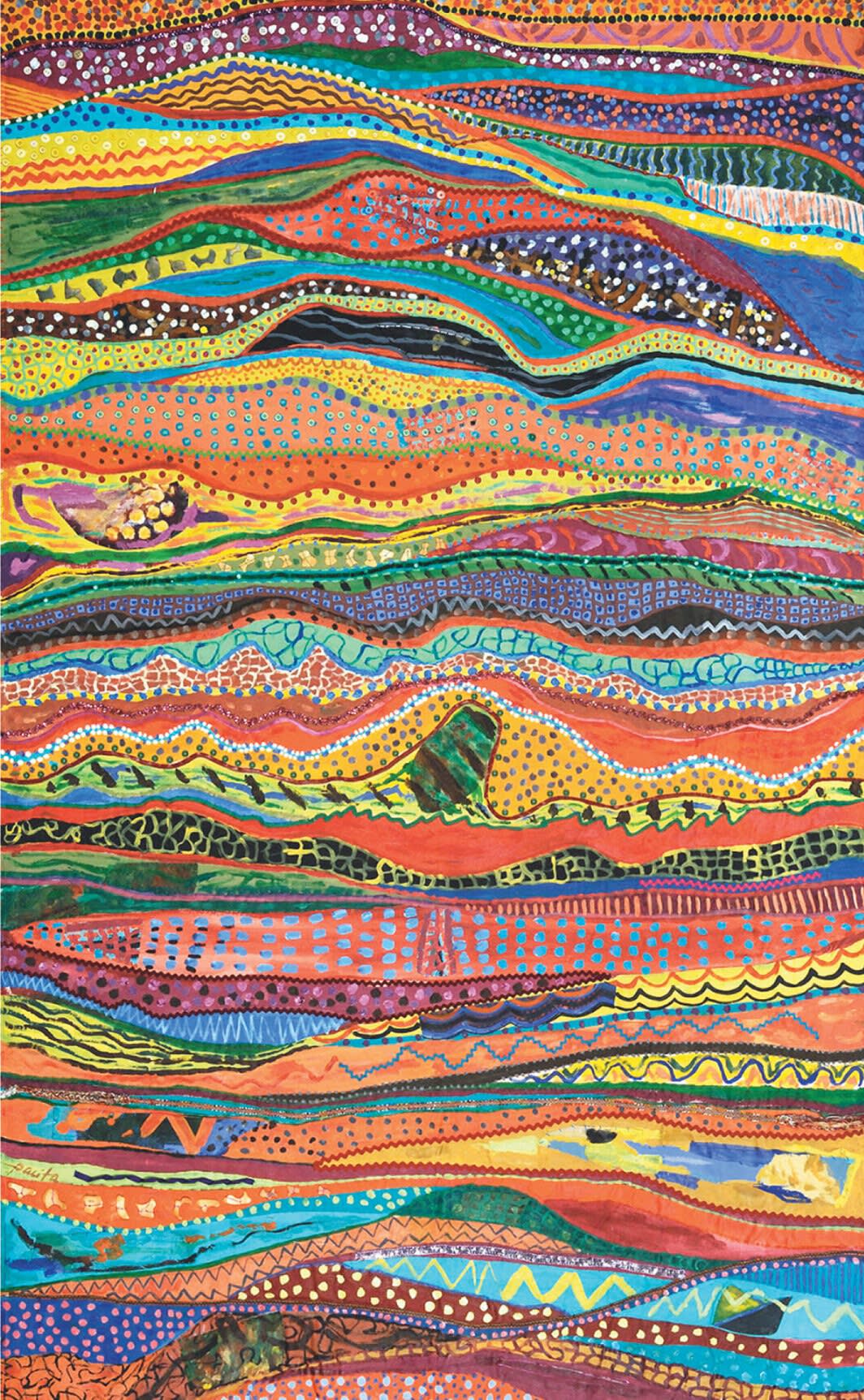
“Pacita Abad” is on view through September 3 at the Walker Art Center, Minneapolis; travels to the San Francisco Museum of Modern Art, October 21, 2023–January 28, 2024; moma ps1, New York, March 28–September 2, 2024; Art Gallery of Ontario, Toronto, October 12, 2024–January 19, 2025.
Murtaza Vali is a writer and curator based in Sharjah and Brooklyn.


